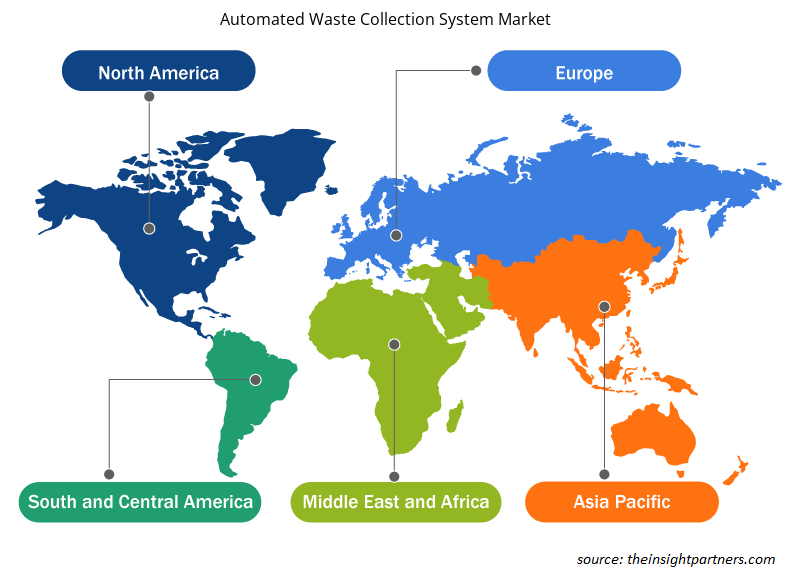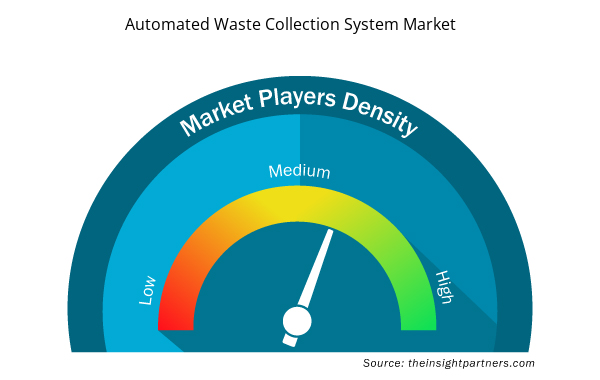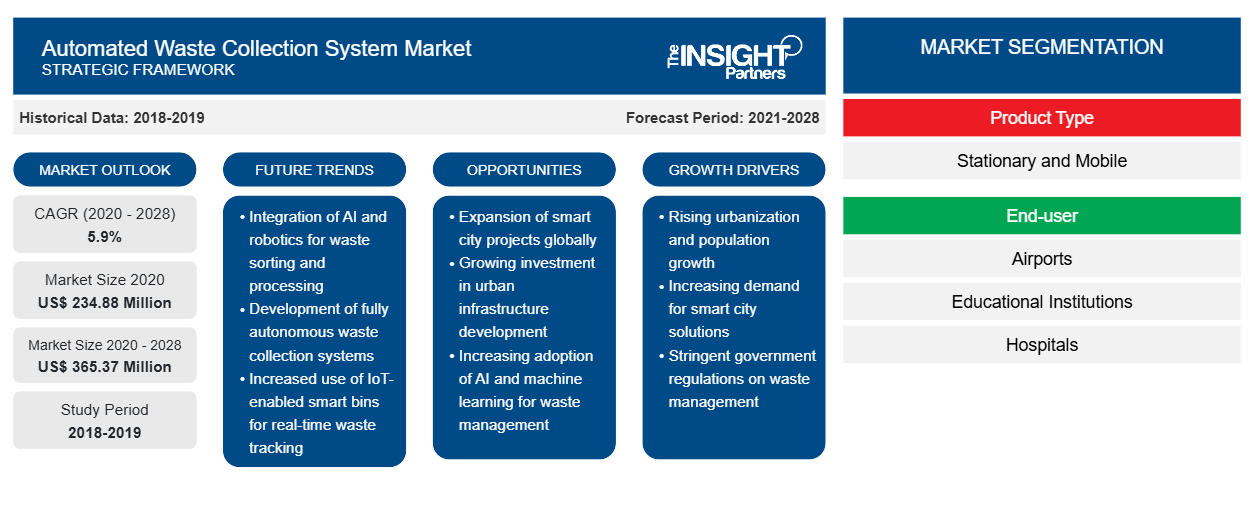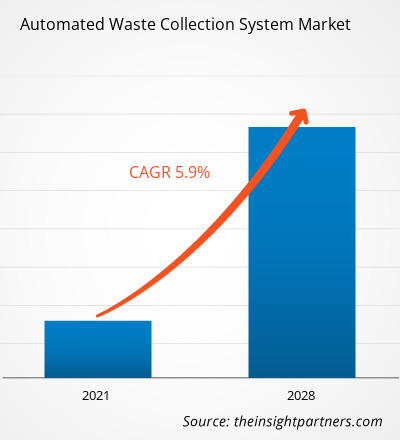2020 年自动垃圾收集系统市场价值为 2.3488 亿美元,预计到 2028 年将达到 3.6537 亿美元;预计 2021-2028 年期间的复合年增长率为 5.9%。
推动自动垃圾收集系统市场发展的关键因素是政府为妥善处理垃圾而采取的举措。世界各地的政府机构都制定了垃圾收集和分类的规则和条例。例如,印度政府制定了新的固体废物管理规则,强调在源头对垃圾进行分类。新法规要求在源头对垃圾进行分类,以通过回收、再利用和再循环将其转化为资本。因此,在将垃圾交给收集者之前,垃圾产生者必须将其分为三类——可生物降解垃圾、干垃圾(塑料、纸张、金属、木材等)和家庭有害垃圾(尿布、餐巾纸、驱蚊剂、清洁剂等)。然而,大规模垃圾分类是一个繁琐的过程,这迫使政府当局专注于垃圾分类的自动解决方案。这些因素正在影响全球许多国家采用自动垃圾收集系统。
定制此报告以满足您的需求
您可以免费定制任何报告,包括本报告的部分内容、国家级分析、Excel 数据包,以及为初创企业和大学提供优惠和折扣
- 获取此报告的关键市场趋势。这个免费样品将包括数据分析,从市场趋势到估计和预测。
COVID-19 疫情对自动垃圾收集系统市场的影响
然而,由于地区和地方政府鼓励市政当局和私人组织投资智能垃圾收集和分类解决方案,全球的自动垃圾收集系统制造商受到的冲击有限。随着住宅垃圾量大幅增加,住宅部门对自动垃圾收集系统的需求飙升。然而,由于人员流动受限导致供应链中断,导致美国、加拿大、英国、意大利和中国等发达国家和发展中国家的 AWCS 部署和安装速度都较慢。此前,全球自动垃圾收集系统市场的收入增长趋势低于往常
市场洞察——自动垃圾收集系统市场
自动垃圾收集系统集成投资不断增加
自动垃圾收集系统在医疗机构中受到高度青睐。垃圾管理和收集系统以每小时 60 英里的速度通过密封的专用管道网络将材料从病房的装卸站运送到中央收集操作。使用单独的路径将垃圾、堆肥和脏布草运送到适当的收集箱。这导致酒店、医疗保健和零售等行业对自动收集技术的投资增加。例如,Logiwaste AB 已向斯德哥尔摩卡罗琳斯卡医院提供了三种不同的自动垃圾收集系统。这些系统预计将管理四种不同类型的垃圾,即残余垃圾、纸张、塑料和纸包装。Logiwaste AB 还赢得了特隆赫姆 Tiller Öst、卡尔斯塔德中央医院、特隆赫姆 Grilstad Marina 和北京中国人寿的合同,供应 AWCS。同样,Atreo 也获得了为 Parkland 医院、Humber River 医院、布莱根妇女医院和德克萨斯大学西南医学中心等提供 AWCS 的项目。因此,不同行业(尤其是医疗保健行业)的组织对实施自动废物收集和管理系统的投资不断增加,预计将在未来几年推动市场的增长。
基于产品类型的洞察
根据产品类型,自动垃圾收集系统市场分为固定式和移动式。固定式部分在 2020 年占据了更大的市场份额。
基于内容质量的洞察
根据最终用户,自动垃圾收集系统市场分为机场、教育机构、医院、公司办公室、酒店/餐厅等。预计机场部分在预测期内的复合年增长率最高。
自动垃圾收集系统市场的参与者主要专注于开发先进、高效的产品。
- 2021 年,Caverion 为生物技术公司 Thermo Fisher Scientific Baltics 的新大楼实施了交钥匙工程。该项目位于立陶宛维尔纽斯。
- 2021 年,斯塔万格大学医院选择了 Logiwaste AB 的自动垃圾和衣物收集系统。该系统从入口门一直到终端,提供用户友好、高效且卫生的垃圾和衣物处理方式。
自动垃圾收集系统市场区域洞察
Insight Partners 的分析师已详细解释了预测期内影响自动垃圾收集系统市场的区域趋势和因素。本节还讨论了北美、欧洲、亚太地区、中东和非洲以及南美和中美洲的自动垃圾收集系统市场细分和地理位置。

- 获取自动垃圾收集系统市场的区域具体数据
自动垃圾收集系统市场报告范围
| 报告属性 | 细节 |
|---|---|
| 2020 年市场规模 | 2.3488亿美元 |
| 2028 年市场规模 | 3.6537 亿美元 |
| 全球复合年增长率(2020 - 2028) | 5.9% |
| 史料 | 2018-2019 |
| 预测期 | 2021-2028 |
| 涵盖的领域 | 按产品类型
|
| 覆盖地区和国家 | 北美
|
| 市场领导者和主要公司简介 |
|
市场参与者密度:了解其对商业动态的影响
自动垃圾收集系统市场正在快速增长,这得益于终端用户需求的不断增长,这些需求源于消费者偏好的不断变化、技术进步以及对产品优势的认识不断提高等因素。随着需求的增加,企业正在扩大其产品范围,进行创新以满足消费者的需求,并利用新兴趋势,从而进一步推动市场增长。
市场参与者密度是指在特定市场或行业内运营的企业或公司的分布情况。它表明在给定市场空间中,相对于其规模或总市场价值,有多少竞争对手(市场参与者)存在。
在自动垃圾收集系统市场运营的主要公司有:
- 阿尔宾APS
- AMCS集团
- 卡维里恩公司
- 恩华特公司
- Logiwaste 公司
免责声明:上面列出的公司没有按照任何特定顺序排列。

- 获取自动垃圾收集系统市场顶级关键参与者概述
自动垃圾收集系统市场细分如下:
自动垃圾收集系统市场——按产品类型划分
- 固定式
- 移动的
自动垃圾收集系统市场 – 按最终用户划分
- 机场
- 教育机构
- 医院
- 公司办公室
- 酒店 / 餐厅
- 其他的
自动垃圾收集系统市场 – 按地区划分
北美
- 我们
- 加拿大
- 墨西哥
欧洲
- 德国
- 法国
- 意大利
- 英国
- 俄罗斯
- 欧洲其他地区
亚太地区 (APAC)
- 澳大利亚
- 中国
- 印度
- 日本
- 韩国
- 亚太地区其他地区
中东和非洲 (MEA)
- 沙特阿拉伯
- 阿联酋
- MEA 其他地区
南美洲 (SAM)
- 巴西
- SAM 其余部分
公司简介
- 艾尔宾
- AMCS集团
- 卡维里恩公司
- 恩华特公司
- Logiwaste 公司
- MariMatic 公司
- 明光
- 依凡克集团
- 马巴特
- STREAM 环境
- 历史分析(2 年)、基准年、预测(7 年)及复合年增长率
- PEST 和 SWOT 分析
- 市场规模价值/数量 - 全球、区域、国家
- 行业和竞争格局
- Excel 数据集



Report Coverage
Revenue forecast, Company Analysis, Industry landscape, Growth factors, and Trends

Segment Covered
This text is related
to segments covered.

Regional Scope
North America, Europe, Asia Pacific, Middle East & Africa, South & Central America

Country Scope
This text is related
to country scope.
常见问题
Automated waste collection systems are being highly preferred across healthcare institutions. The waste management and collection systems transfer materials at 60 miles per hour through a sealed, dedicated pipe network from loading stations on patient floors to a central collection operation. Separate paths are used to move waste, compost, and soiled linen to the appropriate collection bins. This is leading to the rise in investments in automatic collection technologies in industries such as hospitality, healthcare, and retail. For instance, Logiwaste AB has supplied three different automatic waste collection systems to Karolinska Hospital, Stockholm. These systems are projected to manage four different type of waste, namely, residual waste, paper, plastic, and paper packaging. Logiwaste AB has also won contracts from Tiller Öst, Trondheim; Karlstad Central Hospital; Grilstad Marina, Trondheim; and China Life, Beijing, to supply AWCS. Similarly, Atreo has received projects for supplying AWCS to Parkland Hospital, Humber River Hospital, Brigham and Women’s Hospital, and the University of Texas Southwestern Medical Center, among others. Thus, the rising investments by organizations from different industries, especially healthcare, to implement automatic waste collection and management systems is expected to fuel the growth of the market in the coming years.
Government bodies across the world have imposed rules and regulations for the collection and segregation of waste. For instance, the Government of India has specified new solid waste management rules emphasizing on the segregation of waste at source. The new regulations require waste to be separated at the source to channel it into capital through recovery, reuse, and recycling. Therefore, before handing over waste to the collectors, waste generators must sort it into three streams—biodegradables, dry (plastic, paper, metal, wood, etc.), and domestic hazardous waste (diapers, napkins, mosquito repellants, cleaning agents, etc.). However, the segregation of waste at a high scale is a tedious process, which is compelling government authorities to focus on automatic solutions of waste segregation. These factors are influencing the adoption of automated waste collection systems in many countries worldwide.
The stationary segment led the market in 2019 with highest share and is expected to continue its dominance during the forecast period. In stationary waste collection systems, the garbage is directly transported by pipes with the help of air pressure where it is compressed in seal containers. Thus, it is not required to be collected by trucks. Exhausters produce negative pressure in the pipe system, allowing air to flow freely. At ambient pressure, air enters the pipes, collecting the solid waste and carrying it to the collection station. The automated stationary waste collection systems can manage multiple waste forms simultaneously. In a standard collection method, two to four different waste streams are managed using the same transport pipes network.
Trends and growth analysis reports related to Manufacturing and Construction : READ MORE..
The List of Companies - Automated Waste Collection System Market
- Aerbin APS
- AMCS Group
- Caverion Corporation
- Envac AB
- Logiwaste AB
- Marimatic OY
- MEIKO
- EVAC GmbH
- MBAT
- Stream Environment
The Insight Partners performs research in 4 major stages: Data Collection & Secondary Research, Primary Research, Data Analysis and Data Triangulation & Final Review.
- Data Collection and Secondary Research:
As a market research and consulting firm operating from a decade, we have published and advised several client across the globe. First step for any study will start with an assessment of currently available data and insights from existing reports. Further, historical and current market information is collected from Investor Presentations, Annual Reports, SEC Filings, etc., and other information related to company’s performance and market positioning are gathered from Paid Databases (Factiva, Hoovers, and Reuters) and various other publications available in public domain.
Several associations trade associates, technical forums, institutes, societies and organization are accessed to gain technical as well as market related insights through their publications such as research papers, blogs and press releases related to the studies are referred to get cues about the market. Further, white papers, journals, magazines, and other news articles published in last 3 years are scrutinized and analyzed to understand the current market trends.
- Primary Research:
The primarily interview analysis comprise of data obtained from industry participants interview and answers to survey questions gathered by in-house primary team.
For primary research, interviews are conducted with industry experts/CEOs/Marketing Managers/VPs/Subject Matter Experts from both demand and supply side to get a 360-degree view of the market. The primary team conducts several interviews based on the complexity of the markets to understand the various market trends and dynamics which makes research more credible and precise.
A typical research interview fulfils the following functions:
- Provides first-hand information on the market size, market trends, growth trends, competitive landscape, and outlook
- Validates and strengthens in-house secondary research findings
- Develops the analysis team’s expertise and market understanding
Primary research involves email interactions and telephone interviews for each market, category, segment, and sub-segment across geographies. The participants who typically take part in such a process include, but are not limited to:
- Industry participants: VPs, business development managers, market intelligence managers and national sales managers
- Outside experts: Valuation experts, research analysts and key opinion leaders specializing in the electronics and semiconductor industry.
Below is the breakup of our primary respondents by company, designation, and region:

Once we receive the confirmation from primary research sources or primary respondents, we finalize the base year market estimation and forecast the data as per the macroeconomic and microeconomic factors assessed during data collection.
- Data Analysis:
Once data is validated through both secondary as well as primary respondents, we finalize the market estimations by hypothesis formulation and factor analysis at regional and country level.
- Macro-Economic Factor Analysis:
We analyse macroeconomic indicators such the gross domestic product (GDP), increase in the demand for goods and services across industries, technological advancement, regional economic growth, governmental policies, the influence of COVID-19, PEST analysis, and other aspects. This analysis aids in setting benchmarks for various nations/regions and approximating market splits. Additionally, the general trend of the aforementioned components aid in determining the market's development possibilities.
- Country Level Data:
Various factors that are especially aligned to the country are taken into account to determine the market size for a certain area and country, including the presence of vendors, such as headquarters and offices, the country's GDP, demand patterns, and industry growth. To comprehend the market dynamics for the nation, a number of growth variables, inhibitors, application areas, and current market trends are researched. The aforementioned elements aid in determining the country's overall market's growth potential.
- Company Profile:
The “Table of Contents” is formulated by listing and analyzing more than 25 - 30 companies operating in the market ecosystem across geographies. However, we profile only 10 companies as a standard practice in our syndicate reports. These 10 companies comprise leading, emerging, and regional players. Nonetheless, our analysis is not restricted to the 10 listed companies, we also analyze other companies present in the market to develop a holistic view and understand the prevailing trends. The “Company Profiles” section in the report covers key facts, business description, products & services, financial information, SWOT analysis, and key developments. The financial information presented is extracted from the annual reports and official documents of the publicly listed companies. Upon collecting the information for the sections of respective companies, we verify them via various primary sources and then compile the data in respective company profiles. The company level information helps us in deriving the base number as well as in forecasting the market size.
- Developing Base Number:
Aggregation of sales statistics (2020-2022) and macro-economic factor, and other secondary and primary research insights are utilized to arrive at base number and related market shares for 2022. The data gaps are identified in this step and relevant market data is analyzed, collected from paid primary interviews or databases. On finalizing the base year market size, forecasts are developed on the basis of macro-economic, industry and market growth factors and company level analysis.
- Data Triangulation and Final Review:
The market findings and base year market size calculations are validated from supply as well as demand side. Demand side validations are based on macro-economic factor analysis and benchmarks for respective regions and countries. In case of supply side validations, revenues of major companies are estimated (in case not available) based on industry benchmark, approximate number of employees, product portfolio, and primary interviews revenues are gathered. Further revenue from target product/service segment is assessed to avoid overshooting of market statistics. In case of heavy deviations between supply and demand side values, all thes steps are repeated to achieve synchronization.
We follow an iterative model, wherein we share our research findings with Subject Matter Experts (SME’s) and Key Opinion Leaders (KOLs) until consensus view of the market is not formulated – this model negates any drastic deviation in the opinions of experts. Only validated and universally acceptable research findings are quoted in our reports.
We have important check points that we use to validate our research findings – which we call – data triangulation, where we validate the information, we generate from secondary sources with primary interviews and then we re-validate with our internal data bases and Subject matter experts. This comprehensive model enables us to deliver high quality, reliable data in shortest possible time.


 获取此报告的免费样本
获取此报告的免费样本